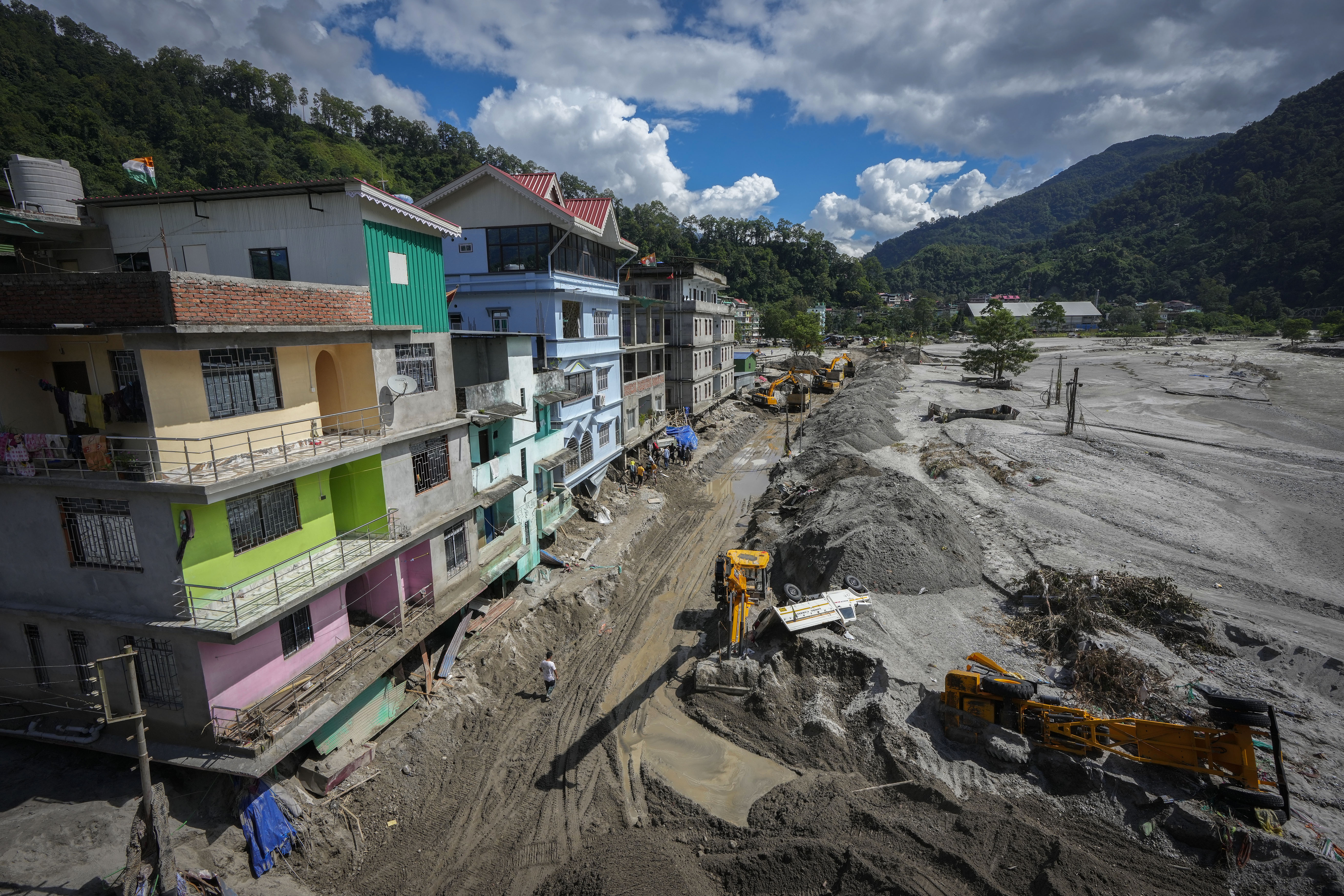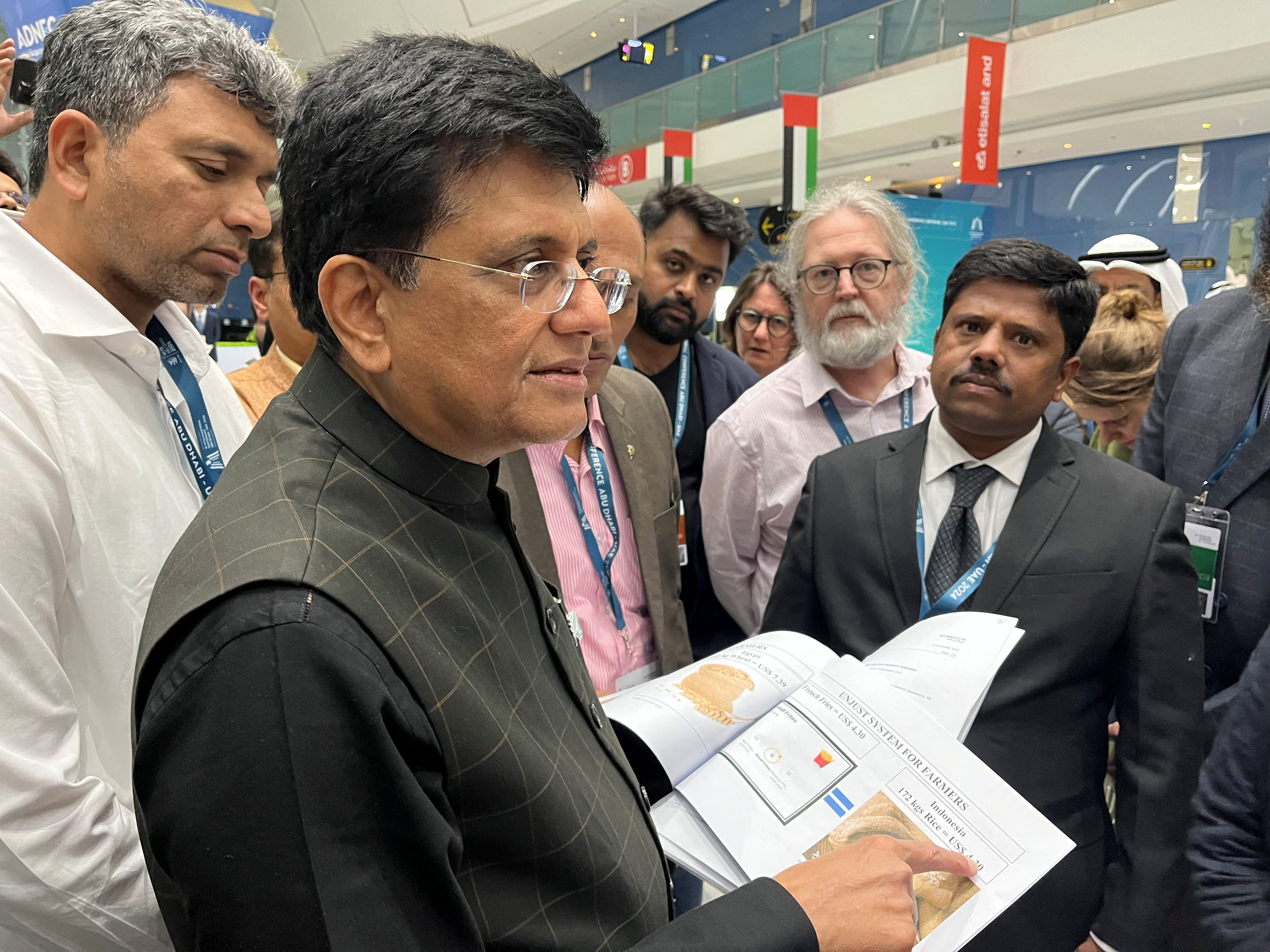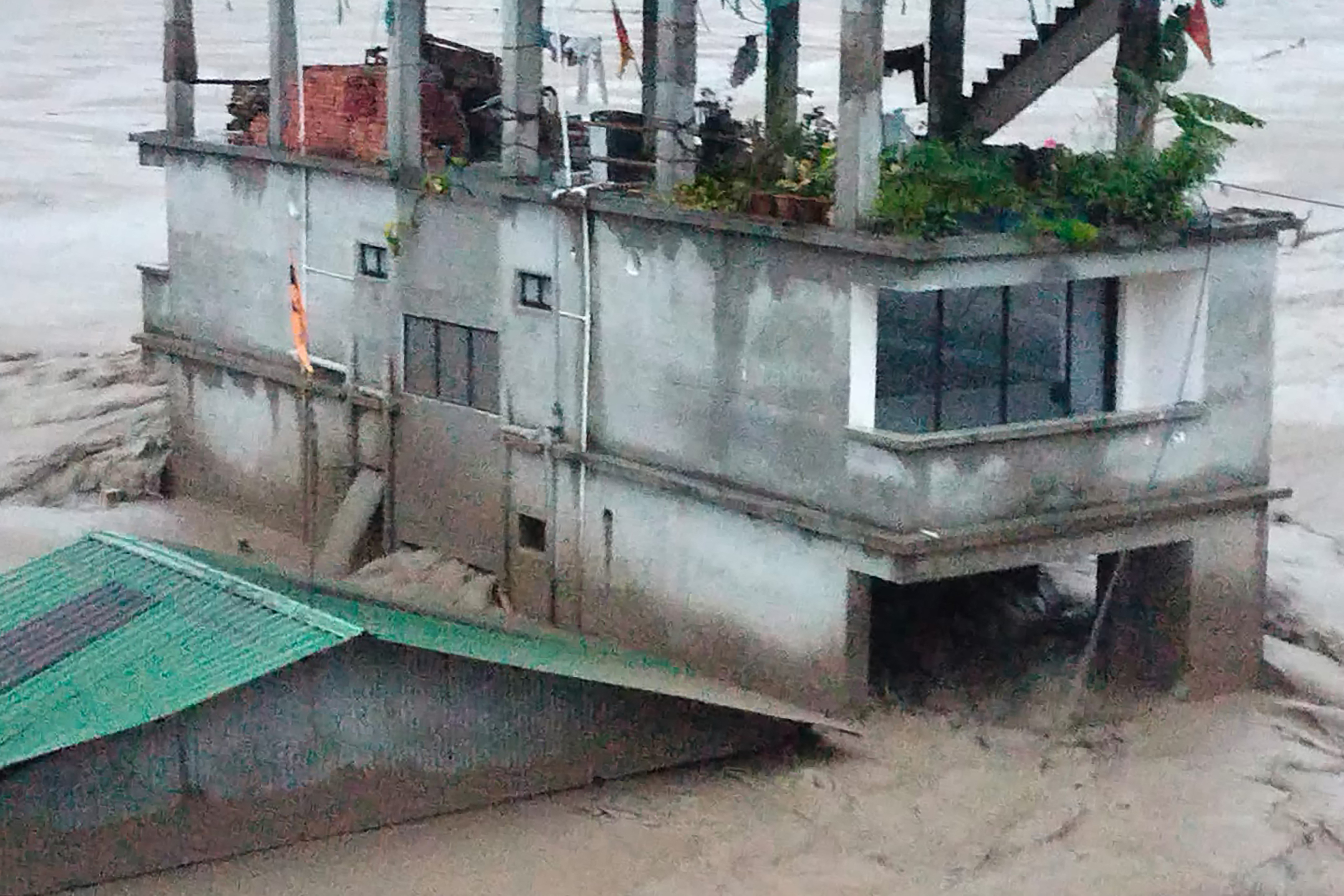
Gangtok, India — When a glacial lake burst through a major dam in India’s northeastern state of Sikkim last October, it destroyed the region’s largest hydro-electric project, the Teesta III.
It also unleashed a torrent of political criticism around the 1200-megawatt (MW) power plant that its proponents had insisted would transform Sikkim’s economy, but for many has instead become emblematic of opacity and alleged corruption around the state’s infrastructure development.
As India’s smallest state — with a population of less than 700,000 people — prepares to vote in national elections on April 19, the now-defunct Teesta III is at the heart of Sikkim’s political campaigns. The state also holds elections for its legislative assembly on Friday.
The flood last October left Sikkim with crippling losses, killed at least 40 people and destroyed property and infrastructure. The state government of the Sikkim Krantikari Morcha (SKM) party has since quietly agreed to sell its majority stake in Teesta III to its minority partner, the Andhra Pradesh-based Greenko Group – pending approval by India’s competition regulator.
But the questions around the project are simmering — and aren’t going anywhere. “If voted to power, or whether we remain in the opposition, the Bharatiya Janata Party [BJP] will initiate a central bureau of investigation [CBI] probe into the Teesta III project, right from the signing of the MoU [memorandum of understanding], to the eventual dam burst to the present sale to a private company, the probe will investigate the corruption aspects,” BJP state spokesperson Pasang G Sherpa told Al Jazeera.
The BJP, under Prime Minister Narendra Modi, rules nationally and is hoping to win a third term in power in the Indian elections that stretch over a month and a half, with results to be declared on June 4.
Greenko has set aside $1.5bn, including taking on an existing $1bn loan, to pay for the purchase. It plans to buy the Teesta III project at par even though a chunk of the power plant has been washed away by floodwaters.
Ganesh Rai, chief minister-aspirant from the newly formed Citizen Action Party (CAP), added that his party had demanded a white paper from the present SKM government on the entire dam burst and eventual sale of Teesta III.
“We suspect huge corruption in the project”, right from the allocation of the project by the previous Sikkim Democratic Front (SDF) to the present SKM government’s tenure, Rai said, adding that corruption in the hydropower sector reached its peak during the SDF era.
Greenko Group, which counts sovereign wealth funds GIC and ADIA as investors, did not respond to multiple requests for information from Al Jazeera.
The controversy dates back to the year 2004 when the small Himalayan state took a bold and ambitious decision. Instead of relying solely on tourism, arguably its largest revenue-generating sector, and allied sectors, it decided to harness its vast water resources through hydropower projects. It did this in tandem with the federal government’s liberalised new hydropower policy for the Himalayan states.
The genesis
The biggest hydropower project, and arguably the costliest, in Sikkim, is the Teesta III. It was developed by a consortium led by the Athena Group through a special purpose vehicle – a separate legal entity created by an organisation – called Teesta Urja Limited (TUL).
The MoU for it was deemed as a model that could be used for other projects. It was the cornerstone in then-Chief Minister Pawan Chamling’s hydro dream for Sikkim.
The initial cost was pegged at 57 billion rupees ($683.43m) but time and cost overruns more than doubled that to 139.65 billion rupees ($1.69bn). It was finally completed five years late in 2017.
Four proposals were received for the development of Teesta III from Cosmos Electric Power Supply Limited, NHPC, Reliance and Sutlej Jal Nigam Vidyut Limited.
A government-established high-powered committee (HPC) had recommended the proposal of the consortium led by Cosmos twice in 2004 to the Sikkim cabinet.
The cabinet first declined the recommendation in October 2004 and on the second occasion, a month later, deferred “for reasons not on record”, the Comptroller and Auditor General, India’s main audit institution, noted.

That same October, Sikkim brought in a new hydropower policy. A new call for proposals in line with the policy received five proposals from the NHPC, National Thermal Power Corporation, SJVNL, Cosmos and a consortium led by Athena Projects Pvt Ltd, India.
Athena India’s proposal met all conditions and its bid was approved by the cabinet a few months later in February. Its consortium included the Andhra Pradesh Power Generating Company, Larsen & Toubro, the Power Trading Corporation of India Limited and the Infrastructure Leasing & Financial Services group.
However, Athena India was incorporated only in August 2004, a few months before it signed the MoU, the CAG report pointed out, and “had no previous experience in implementation of hydel [hydro] projects”. The government “allotted the project to a consortium of private developers without verifying the experience of the consortium leader”, the report said.
TUL, Athena India’s special-purpose vehicle for the project, signed the agreement with the state government. As per that, Athena India was to contribute 74 percent equity in TUL’s capital with the remaining 26 percent coming from the state government. It was to have the finances in place within 12 months and the project completed within five years after that.
The MoU and its violations
As per the MoU, Athena India could not dilute its stake in the project to a third party without the approval of the state government.
However, TUL violated two aspects of the contract. It did not give the state its 26 percent stake, and in 2008, it sold part of the project to Asian Genco Pte Ltd Singapore without the state’s approval. (The state finally got that 26 percent stake in June 2013 after a seven-year delay and had to borrow nearly 3 billion rupees [about $36m] to put in its equity.)
In 2008, TUL took a 45 billion rupees ($539.55m) loan from a consortium of Indian banks. Within a couple of years, Athena reportedly sold close to a 51-percent stake to Asian Genco, making it the majority shareholder. The Singapore-based firm owned by Andhra Pradesh entrepreneur T V Vijaykumar has been linked to Jagan Mohan Reddy, the current chief minister of Andhra Pradesh, who is also the son of its former Chief Minister YS Rajasekhara Reddy.
Enter foreign private equity
In 2010, big-ticket international private equity investors – including Morgan Stanley, Goldman Sachs Investment Management, Everstone Capital, General Atlantic and Norwest Venture Partners – put $425m for a 44 percent stake in Asian Genco, arguably the biggest such deal at the time.
Mauritius-based Varuna Investments Private Limited holds 100 percent preference shares of Singapore-based Asian Genco. (It is not clear who are the beneficiaries of Varuna Investments.)
Those investors soon turned sour and beginning in November 2014, Morgan Stanley Infrastructure Partners and Goldman Sachs Asset Management began complaining about delays at Teesta III as well as another power project investment in a different part of the country.
Teesta III’s holding company, Varuna Investments, appealed to Piyush Goyal, the federal power minister in the newly-inaugurated Narendra Modi-led government, over the constant delays and cost overruns. Chamling’s government bought out their stake in the dam, increasing its share from 26 percent to 51 percent. (That stake was eventually raised to 60.08 percent.)

To facilitate that purchase, the shareholders agreement of TUL was revised three times in 2016 – on January 29, June 30 and on October 6 – according to legal documents submitted by TUL to the federal government and in possession of Al Jazeera.
The revised share agreement, however, lays out a strange situation. As per that document, Asian Genco said that it was formerly called Athena Projects Pte Ltd. However, Athena signed the MoU with the Sikkim government in August 2005 and Asian Genco was formed and registered in Singapore on January 25, 2007, raising the question if the two firms were the same.
However, there was no follow-up action on this either from the Comptroller and Auditor General or the Sikkim government.
According to the Comptroller and Auditor General, Sikkim paid the foreign investors 8.53 rupees ($0.10) per share for a total of 2.66 billion rupees ($30m). The state government accepted the price cited in a valuation report “prepared by TUL [Teesta Urja] through M/s Ernst & Young Merchant Banking Services Private Limited [EY] for internal management analysis purposes” instead of doing an independent valuation.
M N Sherpa, Sikkim’s current power minister, said that the then-state government inexplicably bought the shares at vastly inflated prices by taking a loan of more than 27 billion rupees (nearly $323m). Besides this huge loan, it also had to take on the role of guarantor for a 110 billion rupees ($1.3bn) loan that had been taken by TUL, adding to its loan burden, Sherpa pointed out.
By the time Teesta III was commissioned in February 2017 – at more than three times the original cost – its cost of power now stood at about 6 rupees ($0.07) per unit instead of the original 1.92 rupees ($0.02) per unit. After several states refused to buy power at that jacked-up price, it was forced to sell the power at less than 3 rupees ($0.03) per unit.
Even after TUL was commissioned, it incurred losses for a year – roughly 60 million rupees ($717,000) per day – because it did not have in place all the power evacuation and transmission lines it needed. The All India Power Engineers Federation (AIPEF), an umbrella body of engineers in state-run utilities, submitted the relevant data and documents in this regard to the Ministry of Power.
“The loss was sustained since TUL illegally commissioned the project in 2017, without ensuring the power transmission lines and evacuation system. As a result, it sustained lesser capacity utilisation and spillage losses,” Padamjit Singh, the AIPEF chief patron, told Al Jazeera.
As per guidelines from India’s Central Electricity Authority, which draws up plans for the development of electricity systems, a project can be commercially commissioned only when the related transmission and evacuation infrastructure is in place, he added.
The terribly flawed hydro economics
As per his 2004 plans, former Chief Minister Chamling expected the state to earn 9 billion rupees ($107.9m) every year from 2015 as his state’s share of the revenue from the 21 hydroelectric projects, which would have a combined installed capacity of 4,114 MW and were slated for completion by 2012.

The state had a stake in six projects – between 11 and 26 percent, mostly bought with loans – and was eligible for 12 percent free electricity from all 21 hydropower plants.
But out of the 21 projects, just seven have been completed, with a total of 2,169 MW capacity. Sikkim’s share of power from the projects came in at 144.13 MW, well below the 786.15 MW it needed to meet its original revenue goals.
On October 3 last year, the glacial Lhonak Lake in north Sikkim breached its banks, causing a devastating flood, which wrecked the Teesta III project, located 60km (37 miles) downstream. The power output of the state was reduced to a meagre 266 MW from its 2072 MW capacity. (The flood damaged two other power plants, several roads, bridges and villages, killed at least 40 people and more than 70 went missing.)
A government agency estimated losses at about 2.33 billion rupees ($28m) for the NHPC-run Teesta V project, which is a further 40km (25 miles) down from Teesta III. But there is no official estimate on the actual losses of Teesta III. Sikkim has filed an insurance claim for 114 billion rupees (1.36bn) for damage to the Teesta III project, which is equivalent to the total insured value of the project but is unlikely to receive more than 5 billion rupees ($60m) because of a cap in the contract.
“Once Greenko acquires a 60 percent stake from the government of Sikkim, it becomes the majority owner of the project; it then is entitled to the insurance settlement claim,” Girish Madan, the director at Fitch Rating’s Asia Pacific corporate team which tracks the firm, told Al Jazeera.
Had Greenko opted to wait for a distressed asset sale of Teesta III instead of making its bid of $1.5bn (which includes restoration costs and a takeover of existing debt on Teesta’s balance sheet), it would have had to compete with other potential buyers, “and it would be uncertain how long it would have taken to complete the process”, Madan pointed out.
Since the firm has been a minority partner in the project, it is familiar with the cash generation ability of the project and sees value in this long-term asset, Madan added.
There is no information in the public domain as of now on how much the insurer IFFCO-Tokyo has said it will pay, or whether it has done so already.
The flood also wrecked other math for the state. Its share of free power from the projects was drastically reduced with their output cut back. The state had been bartering that electricity to offset its loan, a process that was severely curtailed now.
Emails from Al Jazeera to Chief Minister Prem Singh Tamang and the power minister’s office remain unanswered.
However, the SKM party has officially denied any wrongdoing in the decision to sell off the project and refuted allegations of corruption, according to local media reports.
Political backlash
Opposition political parties have criticised the deal, saying the government skipped the mandatory statutory board approvals required for the sale of a state asset.
With campaigning season on, the opposition SDF party has filed a public interest litigation in the state High Court against the current SKM government for the disinvestment of the Teesta III dam.
“The present state government did not adhere to Sikkim’s finance rules, general disinvestment policy, or the 2005 implementation agreement between the Sikkim government and TUL,” said Mani Kumar Subba, an SDF spokesperson and the petitioner in the case. The disinvestment goes against the shareholders’ agreement and Sikkim’s hydroelectricity policy, the SDF has alleged in the petition.
The SDF has also filed a public interest litigation in the country’s top court, the Supreme Court of India, regarding the destruction of the Teesta basin from Lhonak Lake to West Bengal. It has blamed the SKM government for criminal negligence and lack of dam safety monitoring.
“Pawan Chamling and his government looted the public exchequer, ruining the state by making it debt-ridden and promoting unviable hydro projects by dubious companies. He should be held accountable,” Y T Lepcha, the BJP legislator of Gangtok and its state vice president, told Al Jazeera. Lepcha, too, filed an FIR against Chamling after the Teesta III dam burst.
Renewed push
The Narendra Modi-led government has not offered any incentives or grant-in-aid to help revive the Teesta III project after the dam break, although a high-level team visited the dam site and took stock of the damages.
The Modi government is, instead, trying to renew two separate and also contentious projects in the state – Teesta Stage IV 520 MW and the Panan 300 MW project. Part of this push is to see through stranded projects and ensure sufficient electricity supply from Sikkim.
The state-run NHPC is developing the Teesta IV, which, according to government data, is scheduled to be completed in 2031-32.
Panan, on the other hand, is being developed by yet another newly-created firm – Himagiri Hydropower Pvt Ltd, a subsidiary of Nagarjuna Fertilisers and Chemicals Ltd. Nagarjuna is a fertiliser and agricultural products manufacturer and Himagiri is the special purpose vehicle it set up to bid on Panan, a contract it won in 2004. Neither firm has any prior experience in hydropower development.
For the past several months, Nagarjuna has been mired in its own debt troubles and its chairman KS Raju, as well as a director in the firm, were previously arrested for allegedly defaulting on payments to depositors at a non-banking financial unit promoted by the group.
Both these projects are in the core zone of the primitive Lepcha tribe habitat of Dzongu as well as the Khangchendzonga Biosphere Reserve, a UNESCO heritage site. The projects have faced about a decade of time and cost overruns primarily due to vehement protests by the Lepchas.
The delay in the Panan project has been aggravated due to the financial crunch faced by the parent company, arrests and legal issues faced by the promoters, and delayed clearances. For now, the project continues to be stalled.
Government data also shows that not only Panan but several other private hydropower projects in Sikkim are stalled, without ascribing reasons, leading to revenue shortfalls for the state.
“As I have said earlier, Teesta III is perhaps the biggest example of a failed private-public partnership project,” said AIPEF’s Singh. “It bent all norms enshrined in the MoU and after culpable negligence, lack of due diligence, corrupt practices unnecessarily increased the project cost, thereby burdening the public exchequer.
Ultimately, look at the fate of the project and the Sikkim government. What have they earned? Just a debt burden.”







